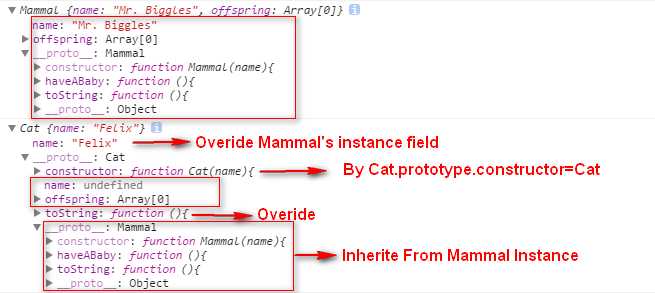标签:
ChildClassName.prototype = new ParentClass();.constructor property for the class using ChildClassName.prototype.constructor=ChildClassName.Function.call() method.To jump right into it, following is a sample showing inheritance between two classes:
function Mammal(name){ this.name=name; this.offspring=[]; } Mammal.prototype.haveABaby=function(){ var newBaby=new Mammal("Baby "+this.name); this.offspring.push(newBaby); return newBaby; } Mammal.prototype.toString=function(){ return ‘[Mammal "‘+this.name+‘"]‘; } Cat.prototype = new Mammal(); // Here‘s where the inheritance occurs Cat.prototype.constructor=Cat; // Otherwise instances of Cat would have a constructor of Mammal function Cat(name){ this.name=name; } Cat.prototype.toString=function(){ return ‘[Cat "‘+this.name+‘"]‘; } var someAnimal = new Mammal(‘Mr. Biggles‘); var myPet = new Cat(‘Felix‘); alert(‘someAnimal is ‘+someAnimal); // results in ‘someAnimal is [Mammal "Mr. Biggles"]‘ alert(‘myPet is ‘+myPet); // results in ‘myPet is [Cat "Felix"]‘ myPet.haveABaby(); // calls a method inherited from Mammal alert(myPet.offspring.length); // shows that the cat has one baby now alert(myPet.offspring[0]); // results in ‘[Mammal "Baby Felix"]‘
The someAnimal & myPet above inner logical struct:

.constructor propertyLook at the last line in the above example. The baby of a Cat should be a Cat, right? While the haveABaby() method worked, that method specifically asks to create a new Mammal. While we could make a new haveABaby() method for the Cat subclass like this.offspring.push(new Cat("Baby "+this.name)), it would be better to have the ancestor class make an object of the correct type.
Every object instance in JS has a property named constructor that points to its parent class. For example, someAnimal.constructor==Mammmal is true. Armed with this knowledge, we can remake the haveABaby() method like this:
Mammal.prototype.haveABaby=function(){ var newBaby=new this.constructor("Baby "+this.name); this.offspring.push(newBaby); return newBaby; } ... myPet.haveABaby(); // Same as before: calls the method inherited from Mammal alert(myPet.offspring[0]); // Now results in ‘[Cat "Baby Felix"]‘

Let‘s extend the example now so that when baby kittens are created, they ‘mew‘ right after being born. To do this, we want to write our own customCat.prototype.haveABaby() method, which is able to call the original Mammal.prototype.haveABaby() method:
Cat.prototype.haveABaby=function(){ Mammal.prototype.haveABaby.call(this); alert("mew!"); }
The above may look a little bit bizarre. Javascript does not have any sort of ‘super‘ property, which would point to its parent class. Instead, you use thecall() method of a Function object, which allows you to run a function using a different object as context for it.
Rather than having to know that Cat inherits from Mammal, and having to type in Mammal.prototype each time you wanted to call an ancestor method, wouldn‘t it be nice to have your own property of the cat pointing to its ancestor class? Those familiar with other OOP languages may be tempted to call this property ‘super‘, but JS reserves this word for future use. The word ‘parent‘, while used in some DOM items, is free for the JS language itself, so let‘s call it parentin this example:
Cat.prototype = new Mammal(); Cat.prototype.constructor=Cat; Cat.prototype.parent = Mammal.prototype; ... Cat.prototype.haveABaby=function(){ var theKitten = this.parent.haveABaby.call(this); alert("mew!"); return theKitten; }
Some OOP languages have the concept of a pure virtual class...one which cannot be instantiated itself, but only inherited from. For example, you might have aLivingThing class which Mammal inherited from, but you didn‘t want someone to be able to make a LivingThing without specifying what type of thing it was. You can do this in JS by making the virtual class an object instead of a function.
The following example shows how this could be used to simulate a pure virtual ancestor:
LivingThing = { beBorn : function(){ this.alive=true; } } ... Mammal.prototype = LivingThing; Mammal.prototype.parent = LivingThing; //Note: not ‘LivingThing.prototype‘ Mammal.prototype.haveABaby=function(){ this.parent.beBorn.call(this); var newBaby=new this.constructor("Baby "+this.name); this.offspring.push(newBaby); return newBaby; }
With the above, doing something like var spirit = new LivingThing() would result in an error, since LivingThing is not a function, and hence can‘t be used as a constructor.
Rather than writing 3 lines every time you want to inherit one class from another, it‘s convenient to extend the Function object to do it for you:
Function.prototype.inheritsFrom = function( parentClassOrObject ){ if ( parentClassOrObject.constructor == Function ) { //Normal Inheritance this.prototype = new parentClassOrObject; this.prototype.constructor = this; this.prototype.parent = parentClassOrObject.prototype; } else { //Pure Virtual Inheritance this.prototype = parentClassOrObject; this.prototype.constructor = this; this.prototype.parent = parentClassOrObject; } return this; } // // LivingThing = { beBorn : function(){ this.alive = true; } } // // function Mammal(name){ this.name=name; this.offspring=[]; } Mammal.inheritsFrom( LivingThing ); Mammal.prototype.haveABaby=function(){ this.parent.beBorn.call(this); var newBaby = new this.constructor( "Baby " + this.name ); this.offspring.push(newBaby); return newBaby; } // // function Cat( name ){ this.name=name; } Cat.inheritsFrom( Mammal ); Cat.prototype.haveABaby=function(){ var theKitten = this.parent.haveABaby.call(this); alert("mew!"); return theKitten; } Cat.prototype.toString=function(){ return ‘[Cat "‘+this.name+‘"]‘; } // // var felix = new Cat( "Felix" ); var kitten = felix.haveABaby( ); // mew! alert( kitten ); // [Cat "Baby Felix"]
Just make sure you call this method immediately after your constructor, before you extend the prototype for the object.
Some OOP languages have the concept of ‘protected‘ methods—methods that exist in a parent or ancestor class that can only be called by descendants of the object (on each other), but not by external objects. These are not supported in JS. If you need such, you will have to write your own framework, ensuring that each class has a ‘parent‘ or some such property, and walking up the tree to find ancestors and checking whether or not the calling object is the same type. Doable, but not enjoyable.
Quote From:
标签:
原文地址:http://www.cnblogs.com/liao-hua/p/4623346.html